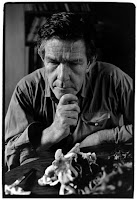 Francisco López is one of the most prolific sound artists active today. Since his earliest releases, more than twenty years ago, he has released well over a hundred albums and has rejuvenated musique concrète through extensive use of field recordings and other types of found sounds. I wrote about Wind [Patagonia], one of his overt field recording albums, here a while back. For as many López works as have a recognizable and sometimes even fully credited provenance, there are albums where he provides no clue whatsoever on the sounds' origins, in notes or in the works themselves. In addition, many of his pieces are untitled and packaged in the most minimal way possible — clear jewel cases, plain white cardboard — obscuring any real-world referents as much as possible in packaging as with sound sources.
Francisco López is one of the most prolific sound artists active today. Since his earliest releases, more than twenty years ago, he has released well over a hundred albums and has rejuvenated musique concrète through extensive use of field recordings and other types of found sounds. I wrote about Wind [Patagonia], one of his overt field recording albums, here a while back. For as many López works as have a recognizable and sometimes even fully credited provenance, there are albums where he provides no clue whatsoever on the sounds' origins, in notes or in the works themselves. In addition, many of his pieces are untitled and packaged in the most minimal way possible — clear jewel cases, plain white cardboard — obscuring any real-world referents as much as possible in packaging as with sound sources. The line between abstract sound object and discernable documentary is continuous, and one of López's first releases in 2010, one of his most evocative sound works to date, takes an oblique tangent to both paths. Released on the isolationist label Glacial Movements, Amarok participates in similar visual imagery as the rest of the label, with the beautiful abstract Bjarne Riesto photograph Flight gracing the cover. There's also a suggestive Inuit connection with the album's name, Amarok being a gigantic wolf in Inuit mythology. López provides no additional clues, no indication of his sound sources in the rather sparse notes, and no obvious sonic referents in the music. With a single track over an hour long, Amarok has a narrative quality that is unusual in López's longer work.
Amarok is dominated by three loud, complex sections that are separated by interludes with varying degrees of tranquility. The first mountain is exactly the sort of great cavernous crescendo I have come to expect from López. Periodic subsonic booms and percussive noise bursts introduce an ominous, murky tension soon after the beginning. A second long section builds further, with breathing sounds and a low rattle suggesting the titular giant wolf growling deep from the back of his throat. While López's trademark resonances fill the background, muffled voices and watery gurgling drift into a soft hum like the arctic wind. There's movement even here, oscillations in space, volume and timbre becoming very quiet, audible only on headphones, and eventually, not even there. The last of the three loud sections starts with an accretion of overtone drones, with circling winds, a deep tumbling, and noises that conjure images of ghost sailors on phantom ships sometimes audible through the fog. This very complex and glorious set of sounds launches into a final quiet drone section.
Anyone with even a passing interest in contemporary drone will have heard some of López's music. His pieces overtly based on field recordings seem to keep their popularity, perhaps because of the high level of activity inside the sounds or the inevitable challenge of picking out small details for identification games. He's also created unsourcable works, nearly featureless expanses constructed from white and pink noise generators sensitively filtered. characterized by the juxtaposition of extended monolithic sound blocks, without any obvious connection between them. Amarok is neither of these. With complex, thick sound masses that draw us to López in the first place, it also has substantial continuity and development, unified perhaps with some of the same sound objects used in the different sections. It has the kind of organic development that I hear in López' naturalist works, sonic fields alive with possibilities. And it has a balance between onslaught and silence that's essential in a long form, all of which make Amarok one of López's most significant works to date.



